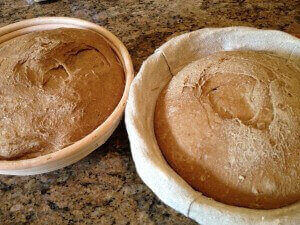Dough and Refrigeration
Jul 23, 2012Posted by Forno BravoLonger fermentation times release more flavors from the grains we use and gives the yeast and enzymes in our dough more time to break down the carohydrates that are present. I recently read that a well developed dough can have up to 300 different flavor molecules. My guess is that we all pretty understand this at some level, but in general we might be too busy or rushed to actually do something about it. I know that all too often I simply decide to make bread and compress the entire mixing, kneading, stretching, folding, fermenting, shaping, proofing and scoring process down into a matter of hours.
But good bread needs more time. They keep telling us, and I am trying to listen. So recently, I have been starting to take the time to plan ahead and refrigerate my dough. Once I can internalize the processes and make them natural — and make sure that I do more planning ahead — I think this will be a big step forward in improving my bread.
Thinking for a minute, there seem to be a number of different places in the break making process where you can retard fermentation and slow things down. Off the top of my head, you can use ice water to mix your dough, you can mix your dough and drop it straight into the refrigerator, you can bulk ferment your dough (and stretch and fold it), and then put it in the refrigerator, and you can shape your loaves and put them in the refrigerator. I’m sure there are other methods that I haven’t thought of.
The other day, I was behind in firing my oven and knew that waiting for my pizza oven to cool down into bread baking temperatures could take a long time and that my loaves would over-proof. So I put them in the refrigerator and only pulled them out right before I loaded them into the oven. It might not have been pre-planned or even the right way to plan things, but it worked out really well. I think it’s a new tool in my bread baking kit.
One thing I need to think about is how to best protect my dough from the air and things going on in the refrigerator. The loaves above were stored for 4 hours after they were shaped, and I covered them with a towel. You can see that they developed a pretty thick skill top. Though in this case, the “top” was the bottom, as I flipped the loaves onto a peel, and scored them. I think I need to think about a system with plastic covers. Well, maybe.
Of course there are lots of hobbyists and professionals who always ferment their pizza dough overnight, and sometimes longer. The extra time your dough matures gives it great flavors, and it improves how well your pizza “chars”.
So tonight, I just mixed a 1Kg batch of whole wheat oat and oat bran batch and it’s going to sleep overnight in the refrigerator. Tomorrow I will let it warm up, and stretch and fold my way into what I hope are a couple of nice loaves.






